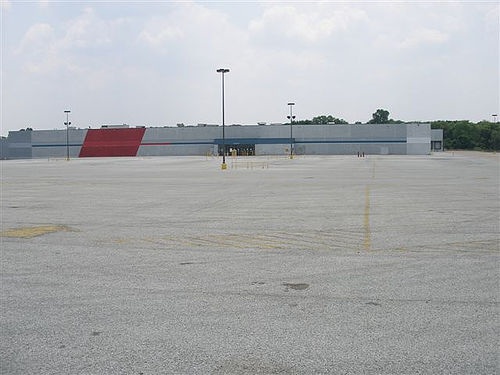Is there anything worse than having a Walmart open in one’s community? Look at the pestilence Walmart breeds: The Mom and Pop stores cannot compete with the always-low prices. The landscape becomes a homogenous landscape of big-box stores and parking lots. The populace begins to take delight in cheap consumer good acquisition, breeding a society of soulless denizens who value convenience, conformity, and cars big enough to cart home enough crap to fill the void in their life that TV isn’t covering.
But there is something worse than a Walmart opening, and that’s a Walmart closing. Having a new Walmart is the modern-day equivalent of a station stop on a cross-country train: Instant boomtown. Yes, the small-business owners leave, but they are replaced by other businesses – car dealerships, restaurants, gas stations – that don’t have to compete head-to-head with Walmart and that feed off of Walmart’s traffic. The town becomes a commercial destination and reaps tax benefits. And even if the jobs pay depressed wages, at least there are jobs. Once Walmart digs its claws in, the community depends on the Walmart. So what happens to this town when Walmart decided to leave?
Last year, I was talking to a co-worker who used to be a consultant for towns with wealthy home-owners eager to understand the future impact of proposed development. I told him about how I grew up in a small town with a sewer moratorium that prevented any commercial construction until the mid-1990s, and then the moratorium was lifted and the town imploded into a mess of chain stores and traffic lights. “There’s even a Walmart,” I said. The co-worker then proceeded to offer insight into the building lifecycle of a Walmart.
Because my company is all about building lifecycle, I knew what he was talking about, but for those of you who are not lucky enough to work in the field of facilities management, let me explain. Every building has a lifecycle. For example, a building built in 1990 may have a boiler that lasts 30 years, flooring that lasts 25 years, and an HVAC system that lasts 20 years. These building components must be replaced, totally or partially, in order for the building to function. In buildings that are built to last – office buildings, city halls, schools, hospitals – this lifecycle of replacement is a necessity.
But according to my co-worker, Walmarts aren’t built to last. They’re built to last 20 years. Walmart realized long ago that today’s ideal store location probably won’t be ideal in 20 years, because as noted above, a Walmart changes a community. They are strategic about their locations. Ever wonder why a Walmart will open within 10 miles of another Walmart? To inundate a large area with always-low prices and run competitors out of town, even at the risk of stealing business from each other. 70% of Wal-Marts are leased, allowing stores to be easily abandoned. And with the dawn of the Supercenter, thousands of Walmarts too small to serve Walmart’s purpose, so they relocate, leaving a massive deteriorating carcass behind. Most former Walmarts (at least 400 nationwide) remain empty, although a few serve as churches, and several communities toy with the idea of turning them into jails.
With thousands of Walmarts built 1990s about to enter the end of their useful lifecycle, soon America will be filled with abandoned Walmarts. It is a chilling thought. Because the only thing more depressing than seeing my hometown transformed into a bustling Walmart town would be seeing it as a ghost town with an empty 144,000-square-foot big box store presiding over an expanse of concrete.

